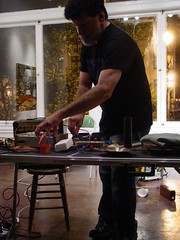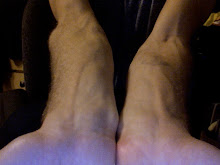Orhima / Pharmakon / R. Jencks
Hemlock Tavern, San Francisco
Tuesday, August 25, 2009
 It had been a long time since I had visited the Hemlock Tavern. It seems that enterprising avant gardists have largely given up on trying to present their music in this particular rock music context; the loud bar atmosphere on the other side of the plastic curtain is only the most obvious obstacle in the way of sensitive music emerging here. But there is no need for politeness tonight; I am here to hear a metal band – a black metal band that a Bay Area noise fan would consider a supergroup. Orhima features members of acoustic grind duo Ettrick, Nerds-fueled tablecore Tralphaz, and microcephalic face-synthesist Bran (...) Pos, respectively on drums, guitar, and vocals. Lit by nought but a single bright lightbulb center stage on the floor, the blackened, bloodied drummer pounds out simple, brutal rhythms, while a dispassionate goth flutter-strums his guitar into a wash of white noise. Barefooted and velvet-cloaked, the weirdo singer wails wild howls of the criminally insane. Their music filled me with joy. Tastefully simple heavy rock music with crazy vocals and creepy background music filling in the space between songs. A variety of tempo changes, both gradual and abrupt, add variety. This is, I believe, only their third show with this finalized line-up. With a bit more experience, they will be a brutal juggernaut. They're off to a solid start.
It had been a long time since I had visited the Hemlock Tavern. It seems that enterprising avant gardists have largely given up on trying to present their music in this particular rock music context; the loud bar atmosphere on the other side of the plastic curtain is only the most obvious obstacle in the way of sensitive music emerging here. But there is no need for politeness tonight; I am here to hear a metal band – a black metal band that a Bay Area noise fan would consider a supergroup. Orhima features members of acoustic grind duo Ettrick, Nerds-fueled tablecore Tralphaz, and microcephalic face-synthesist Bran (...) Pos, respectively on drums, guitar, and vocals. Lit by nought but a single bright lightbulb center stage on the floor, the blackened, bloodied drummer pounds out simple, brutal rhythms, while a dispassionate goth flutter-strums his guitar into a wash of white noise. Barefooted and velvet-cloaked, the weirdo singer wails wild howls of the criminally insane. Their music filled me with joy. Tastefully simple heavy rock music with crazy vocals and creepy background music filling in the space between songs. A variety of tempo changes, both gradual and abrupt, add variety. This is, I believe, only their third show with this finalized line-up. With a bit more experience, they will be a brutal juggernaut. They're off to a solid start.I hear murmurs of "female power electronics" as Pharmakon, a young New Yorker, sets up. More than a few people are excited to hear her, so I decide to stick around to see how the actuality matches the preceding reputation. The Hemlock has provided this young lady with a large white table with a graffito: "Twat?" O fate! She sets up on the floor. A dark synth line from a Casio SK-5 toy keyboard begins the set; it's nice to see the actual movement of two fingers producing this music, neither pre-recorded nor sequenced. Soon she deploys her special skill: terrified womanish screaming. She is certainly well-practiced in this art; approach her not in a dark alley. Bursts of electronic noise erupt, and a wall of distortion now dominates the sonic atmosphere. Now back to the head; the bass synth line returns, and more bursts of noise conclude the piece. The set is very short, perhaps five minutes, which seems tasteful given the extremely abrasive nature of the music, and her status as an up-and-coming performer rather than a seasoned master.
R. Jencks surprises me with a quick set-up. I'm shooting the breeze at the water cooler when I hear tormented screams bellowing out from behind the shower curtain sealing off the music room. Inside, Mr. Jencks is onstage, wildscreaming into two handheld mics, recordin loops. His rage is palpable. He looks sincerely angry, and in between screams he looks exhausted. For unknown reasons he kicks over a table and throws a mic stand. It feels slightly dangerous. This tension sustains interest in the performance through many minutes of nothing more than primal scream therapy. Eventually I start to perceive subtle pitch shifting affecting the deeper layers of the dense loops: the earliest howls are dropping in pitch. This slow progression has taken so long it seems as if this slight development will be the totality of the set. But now heavily distorted tones, harsh noise, rip out of the speakers. Jencks abruptly cuts the vocal loops, and concentrates on amazing electronic sounds: shredding high-pitched tones, and feedback through delay and distortion. Simple, unchanging sounds, but Jencks is cycling through them quickly, nimbly. His years of experience with this music are evident. A dark, droning synth tone creeps in, underlying everything. It occurs to me that this set contains all the same basic elements as Pharmakon's, and nothing more. Jencks sustains the single synth note a very long time, letting the harsh noise fade away. After ample droning, he quickly recapitulates the whole set. There are more brutal screams followed by more harsh noise, then the synth drone is again left as a solo voice. More onstage furniture is flung. This performance has not been cathartic for Jencks; it has merely fostered, stimulated, his rage and aggression. The looping layers of screams from the beginning of the set return, and the drone is abruptly cut. Fog suddenly starts filling the room. Has this familiar aspect of his set been saved for the conclusion (perhaps forbidden by the club, and executed after it is too late for them to pull the plug on him), or is it cuing the beginning of an entire new section, as did the introduction of the distorted electronics? Synth tones and speech are audible, rising out of the chaotic looping screams. It is starting to feel like a terrible 1980s movie sample will conclude the performance, but then I realize this is the spooky intro (with Vincent-Price-impersonating narrator) to Motley Crue's Shout at the Devil. The album's title track starts playing, and the whole audience is mystified. Some are visibly more excited by this music than by anything else they've heard tonight, but I, on the other hand, have always agreed with Robert Christgau's impression of the album as, "utter dogshit even by heavy metal standards." Vince Neil screams, "Shout at the...," over a snare roll, and the music is cut. What an absurd ending! Inexplicable. Perhaps a nod to the opening metal band, to accompany his genre similarity with Pharmakon.
Labels: live performance reviews
 Then to the Luggage Store Gallery just in time to hear Phillip Greenlief and David Boyce's tenor sax duo. Their rich sounds filled the room, a perfect space for such a duo. And a like-instrument duo is an ideal group for a saxophone to my ears. The best way for a saxophone to unapologetically exist as saxophone, something a bit harder to do in the Bay Area's heavily textural free improv scene. Greenlief and Boyce were perfectly, mind-bogglingly synced up harmonically and rhythmically. It sounded like they were intermittently referencing tunes and structures in their collective vocabulary, but perhaps they just have an amazing sense for playing together. I think I heard some Sun Ra underlying their encore, but Greenlief chose not to sync up too directly. This was a great setting for this duo, and they played wonderfully. The audience responded very enthusiastically.
Then to the Luggage Store Gallery just in time to hear Phillip Greenlief and David Boyce's tenor sax duo. Their rich sounds filled the room, a perfect space for such a duo. And a like-instrument duo is an ideal group for a saxophone to my ears. The best way for a saxophone to unapologetically exist as saxophone, something a bit harder to do in the Bay Area's heavily textural free improv scene. Greenlief and Boyce were perfectly, mind-bogglingly synced up harmonically and rhythmically. It sounded like they were intermittently referencing tunes and structures in their collective vocabulary, but perhaps they just have an amazing sense for playing together. I think I heard some Sun Ra underlying their encore, but Greenlief chose not to sync up too directly. This was a great setting for this duo, and they played wonderfully. The audience responded very enthusiastically. Fantastic set from Dijkstra/Robair/Smith. Bold sounds, static and loud, turning on and off. Blaring sax long tones, electronic textures, arco grinding. Intensity and momentum maintained for a 40-minute set broken into 3 pieces. The double bass sounded HUGE in the room, more like I was inside the bass. Hands rubbed on the wooden body ripped through the room, with full body resonance audible, surrounding me. 4-string pizzicato with bows wedged between the strings sounded like the bass was about to be destroyed, but it all held together. Robair was all over the place with Blippoo Box textures, bowed styrofoam, cymbals, cookie tins on the cement floor, vibrators on everything. Dijkstra weaved in and out on alto sax, and added electronic layers with his Lyricon wind synth through effects. Very rich sound, and great pacing. Nice view of and through the windows backing it all up, and the art hanging there was also actually pretty good for a change. Veggie burrito from Cancun was only mildly better than the decrepit super pollo asado I got last time I went to the Luggage Store. The Market Street branch has fallen far, even though it has always been recognized as the worst of the three. Next time I dine at home, or follow Damon's example and hit up Tu Lan.
Fantastic set from Dijkstra/Robair/Smith. Bold sounds, static and loud, turning on and off. Blaring sax long tones, electronic textures, arco grinding. Intensity and momentum maintained for a 40-minute set broken into 3 pieces. The double bass sounded HUGE in the room, more like I was inside the bass. Hands rubbed on the wooden body ripped through the room, with full body resonance audible, surrounding me. 4-string pizzicato with bows wedged between the strings sounded like the bass was about to be destroyed, but it all held together. Robair was all over the place with Blippoo Box textures, bowed styrofoam, cymbals, cookie tins on the cement floor, vibrators on everything. Dijkstra weaved in and out on alto sax, and added electronic layers with his Lyricon wind synth through effects. Very rich sound, and great pacing. Nice view of and through the windows backing it all up, and the art hanging there was also actually pretty good for a change. Veggie burrito from Cancun was only mildly better than the decrepit super pollo asado I got last time I went to the Luggage Store. The Market Street branch has fallen far, even though it has always been recognized as the worst of the three. Next time I dine at home, or follow Damon's example and hit up Tu Lan.
